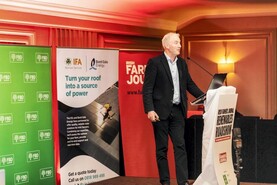The break even price for milk this year could be as high as 33.3 to 35.3c/l, excluding VAT, for many dairy farms, Teagasc has forecast.
This figure does not include farmers’ own labour, which if costed in at 6 to 7c/l, takes the break even price to 39-42c/l, excluding VAT.
Most dairy processors paid an all-in price of 40 to 43c/l, excluding VAT, for milk in December.
A series of meeting in January between Teagasc advisory staff and dairy discussion groups identified significant increases in milk production costs across the sector.
Teagasc described the jump in costs as “sobering” and cautioned that a concerted effort will be needed to address the issue in 2024. The following trends were identified in the assessment of 2023 milk supply relative to 2022:
Milk solids per cow and per hectare declined by 5% (501kg to 478kg and 1,453kg to 1,385kg, respectively);Peak cow numbers increased by 2%;Total value of milk sales declined by 29%; Purchased concentrate declined by 8% or 0.65c/l; Purchased forage increased by 14% or 0.12c/l; Fertiliser costs declined by 22%; Total variable costs were relatively static, declining by 3%; Total fixed costs increased by 10%; The net outcome of these changes was a 66% reduction in dairy farm margin (including own labour charges, but excluding tax and capital costs). Cost increase
Joe Patton of Teagasc stressed that the findings from this consultation did not provide ‘national average’ figures.
However, he said the process highlighted the extent to which costs have increased significantly at farm level over the last two years.
“The findings give a good picture of the sharply declining profit trend that virtually every dairy farmer experienced in 2023,” Patton said.
“It’s a good exercise to talk costs, and we definitely felt that some of the meetings were sobering after a good year in 2022,” he added.
While Patton pointed out that there is a “huge range” in production costs between dairy farms, he said the consultation process with discussion groups suggested that the outlook for margins remained extremely tight this year.
The break even price for milk this year could be as high as 33.3 to 35.3c/l, excluding VAT, for many dairy farms, Teagasc has forecast.
This figure does not include farmers’ own labour, which if costed in at 6 to 7c/l, takes the break even price to 39-42c/l, excluding VAT.
Most dairy processors paid an all-in price of 40 to 43c/l, excluding VAT, for milk in December.
A series of meeting in January between Teagasc advisory staff and dairy discussion groups identified significant increases in milk production costs across the sector.
Teagasc described the jump in costs as “sobering” and cautioned that a concerted effort will be needed to address the issue in 2024. The following trends were identified in the assessment of 2023 milk supply relative to 2022:
Milk solids per cow and per hectare declined by 5% (501kg to 478kg and 1,453kg to 1,385kg, respectively);Peak cow numbers increased by 2%;Total value of milk sales declined by 29%; Purchased concentrate declined by 8% or 0.65c/l; Purchased forage increased by 14% or 0.12c/l; Fertiliser costs declined by 22%; Total variable costs were relatively static, declining by 3%; Total fixed costs increased by 10%; The net outcome of these changes was a 66% reduction in dairy farm margin (including own labour charges, but excluding tax and capital costs). Cost increase
Joe Patton of Teagasc stressed that the findings from this consultation did not provide ‘national average’ figures.
However, he said the process highlighted the extent to which costs have increased significantly at farm level over the last two years.
“The findings give a good picture of the sharply declining profit trend that virtually every dairy farmer experienced in 2023,” Patton said.
“It’s a good exercise to talk costs, and we definitely felt that some of the meetings were sobering after a good year in 2022,” he added.
While Patton pointed out that there is a “huge range” in production costs between dairy farms, he said the consultation process with discussion groups suggested that the outlook for margins remained extremely tight this year.






 This is a subscriber-only article
This is a subscriber-only article










SHARING OPTIONS: